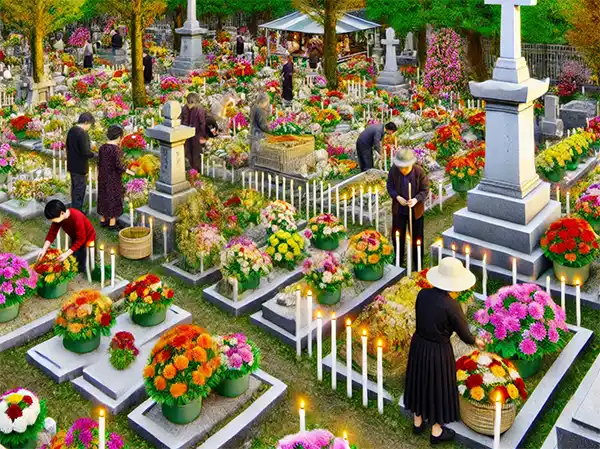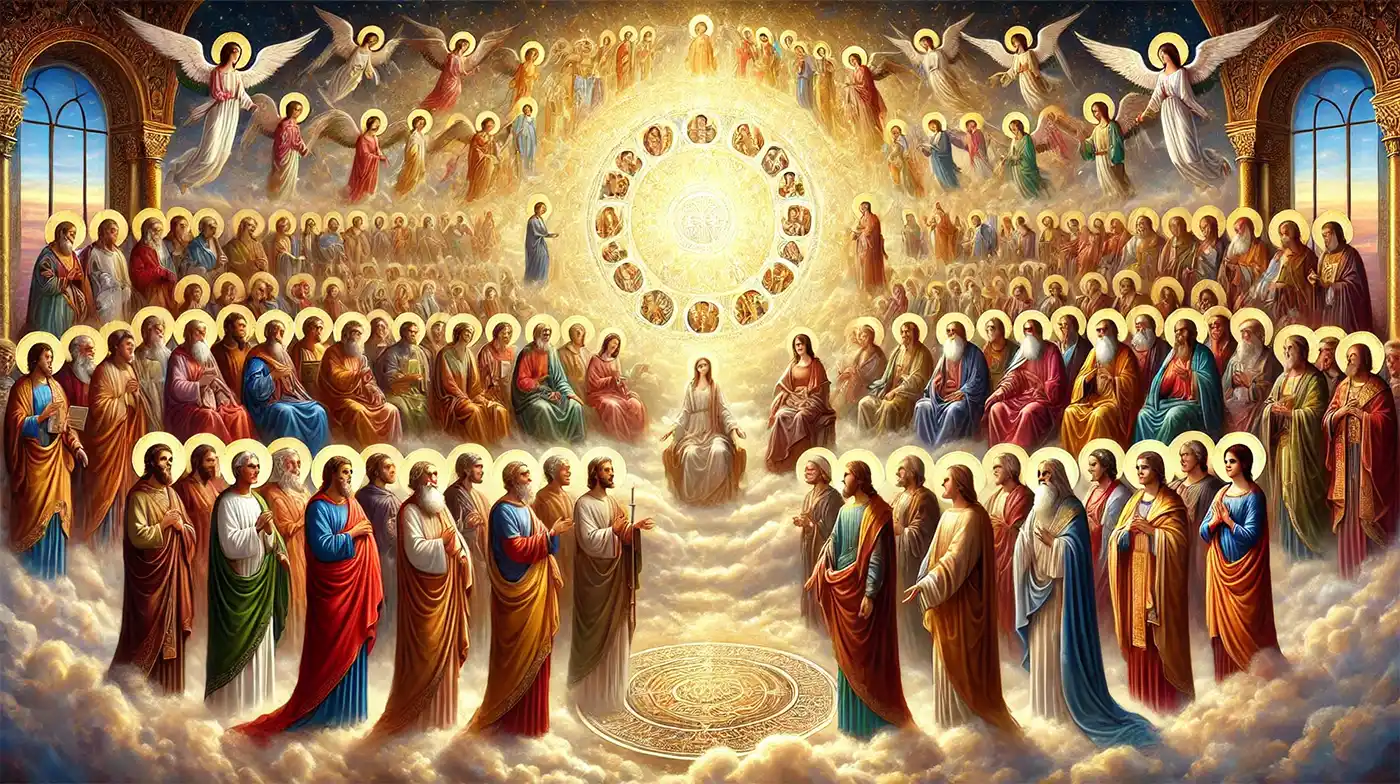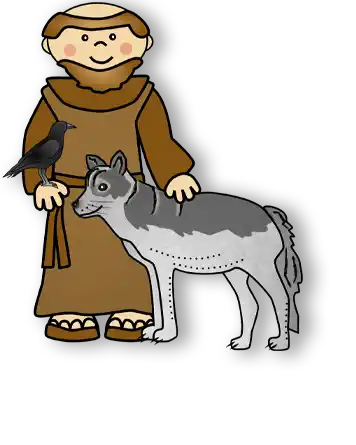A Celebration of Heavenly Heroes
All Saints Day, celebrated on November 1st each year, brings to mind an image of countless saints looking down from their celestial seats, all waving to the faithful below. This holiday, often observed with masses, prayers, and even a few processions, is a chance to honor those who led exemplary lives and have earned a spot in the heavenly “Hall of Fame.” It’s a day that spans centuries of tradition, solemn remembrance, and maybe even a few light-hearted saint jokes for those who appreciate a bit of levity with their liturgy.
A Feast of the Faithful
All Saints Day has its roots in the early centuries of Christianity. Back in those days, being a saint wasn’t a job people took lightly. Saints were typically those who suffered martyrdom for their beliefs, and early Christians sought to remember these faithful few. Originally, these martyrdom anniversaries were celebrated individually, but as the list of saints grew, they decided it was probably easier to honor all saints in one sweeping celebration rather than blocking off every day of the year for individual remembrances.
Pope Gregory III was the first to declare November 1st as All Saints Day in the 8th century, with the focus on both known and unknown saints. The day was, and still is, a chance for believers to reflect on the lives of saints—those who lived for the faith and occasionally did miraculous things, like healing the sick or feeding multitudes with what one might now call miraculous meal prepping.
So, who qualifies as a saint? Well, according to the Catholic Church, saints are people who led holy lives, performed miracles, or died as martyrs. But within this broad category, saints come in all shapes and personalities. There’s Saint Francis of Assisi, known for his love of animals and nature. There’s also Saint Anthony, the saint you call upon when you’ve lost your car keys or can’t find your cell phone. In times like these, Saint Anthony becomes not only a revered saint but possibly the busiest one in heaven, fielding requests from scatterbrained mortals.
Some saints are specialists of sorts, patrons of various professions, causes, or even mishaps. Need protection while traveling? Saint Christopher’s your go-to. Have a particularly tough exam? Try invoking Saint Joseph of Cupertino, the patron saint of test-takers. The array of saints means that nearly every problem has a heavenly figure assigned to it, turning All Saints Day into a day of inspiration for both the devout and those simply seeking a little extra “help from above.”
How People Celebrate All Saints Day
All Saints Day is celebrated across the globe with unique traditions that reflect the diversity of cultures and the special significance this day holds for people everywhere. While the purpose remains the same—to honor saints and loved ones who have passed on—the ways in which people observe this day vary remarkably.
 In France and Poland, All Saints Day is a solemn, almost reverent holiday where families gather at cemeteries to visit the graves of loved ones. They bring flowers, usually chrysanthemums, which are considered symbols of honor and remembrance. The scene transforms into a sea of color as thousands of flowers are laid on gravestones, and candles are lit to symbolize the enduring spirit of the saints and the hope of eternal life. This act not only shows respect for saints and ancestors but also serves as a gentle reminder of life’s fleeting nature.
In France and Poland, All Saints Day is a solemn, almost reverent holiday where families gather at cemeteries to visit the graves of loved ones. They bring flowers, usually chrysanthemums, which are considered symbols of honor and remembrance. The scene transforms into a sea of color as thousands of flowers are laid on gravestones, and candles are lit to symbolize the enduring spirit of the saints and the hope of eternal life. This act not only shows respect for saints and ancestors but also serves as a gentle reminder of life’s fleeting nature.
In Mexico, All Saints Day blends seamlessly with the vibrant festivities of Día de los Muertos, or the Day of the Dead. This two-day celebration, starting with All Saints Day and extending into All Souls Day, is a lively remembrance of both saints and all departed souls. Mexican families build colorful ofrendas (altars) in their homes, adorned with photographs, candles, marigold flowers, and items that their loved ones enjoyed in life. Far from being a somber occasion, it’s a joyful celebration that believes in reconnecting with ancestors who come back to visit for the day. Traditional foods like pan de muerto (bread of the dead) and sugar skulls are enjoyed, and parades fill the streets, showing that honoring the saints can be a lively, spirited affair.
In the Philippines, All Saints Day is celebrated as Undas. Here, it’s customary for families to spend the entire day—or sometimes even the night—at the cemetery, paying respects to loved ones. They bring food, blankets, and sometimes even a tent, as the occasion becomes a sort of reunion of the living and the dead. It’s a time for storytelling, laughter, and sharing memories. People clean and decorate the graves, sometimes repainting the headstones, as an act of devotion to their ancestors. There’s a communal sense of respect, as people share food with neighbors and even strangers, emphasizing the familial nature of the day.
In Italy, churches ring their bells, and the faithful attend special All Saints Day Masses. Many Italian families then head to the cemeteries, just as in other European traditions, bringing flowers to decorate the graves of loved ones. But what makes Italy unique is the culinary tradition that accompanies the day. Special foods are prepared, such as ossi di morto (bones of the dead), which are almond-flavored cookies, along with other seasonal sweets. The day is about remembering the saints, but it’s also about comforting the soul, with the familiar warmth of family, food, and shared memories.
In the United States, All Saints Day isn’t as widely celebrated as in some other countries. However, many Catholic and Anglican churches hold services to honor the saints, both canonized and everyday. In recent years, some congregations have begun using the day as a time to recognize “modern saints”—everyday heroes in their communities who embody selflessness and faith. For example, congregations may spotlight social workers, nurses, and volunteers who make a positive impact. Though there aren’t grand processions or widespread festivities, the day serves as a reflective occasion for many Americans, bridging faith and gratitude in a more personal, introspective way.
Across the world, All Saints Day becomes a reminder of the universality of honoring those who have paved the way in faith. Whether through silent prayer, grand parades, or a day spent in the cemetery with loved ones, the varied traditions remind us that saints—both known and unknown—hold a special place in people’s hearts everywhere.

Modern-Day Saints
For many believers, All Saints Day isn’t just about the famous saints or the canonized figures; it’s a time to celebrate the “saints” among us who live quiet lives of service. That schoolteacher who always stays late to help kids with homework? The grandma who volunteers at the soup kitchen? They may not have performed miracles or faced the lions, but they embody what many consider saintly traits. This broader interpretation means that All Saints Day invites people to recognize holiness in the everyday and to strive for it themselves—no lion’s den required.
Saints are serious business, but even they wouldn’t mind a little light-hearted acknowledgment now and then. After all, some saints were known for their humor. Saint Philip Neri, for instance, was known for his practical jokes and once shaved off half his beard to make people laugh. And it’s said that Saint Teresa of Avila, when nearly falling into a river, quipped to God, “If this is how you treat your friends, no wonder you have so few of them!” Humor, it seems, has a place even in the holiest of hearts.
And then there’s the saint of all saints, if you will—the saint of “finding things” like patience, hope, or even a bit of laughter. In remembering saints like these on All Saints Day, it’s possible to imagine a saintly “comedy club” of sorts, where the holiest of figures chuckle at our human foibles while lending us a divine hand.
Celebrating All Saints Day Today
In today’s world, All Saints Day might look like a mix of traditional masses, candle-lit ceremonies, and maybe a quiet moment spent reflecting on the lives of those who inspire. Some might make it a point to pray to their favorite saint or even learn about a new one. Others could spend the day performing an act of kindness in the spirit of saintly sacrifice. And for those who enjoy a bit of humor, perhaps consider who your “patron saint” would be. Is it Saint Jude, the patron of lost causes? Or maybe Saint Lawrence, who, as he was martyred, joked to his executioners, “Turn me over; I’m done on this side!”
All Saints Day offers a chance to find inspiration, whether it’s from the official canon or simply from people whose lives make us better. It’s a celebration of the heavenly, the hopeful, and, yes, the humorous. After all, even saints might enjoy a laugh now and then.
This All Saints Day, may your humor be light, your heart be full, and your appreciation for the world’s saints be everlasting (or at least last until the evening mass!).
Please Share our Content






 In France and Poland, All Saints Day is a solemn, almost reverent holiday where families gather at cemeteries to visit the graves of loved ones. They bring flowers, usually chrysanthemums, which are considered symbols of honor and remembrance. The scene transforms into a sea of color as thousands of flowers are laid on gravestones, and candles are lit to symbolize the enduring spirit of the saints and the hope of eternal life. This act not only shows respect for saints and ancestors but also serves as a gentle reminder of life’s fleeting nature.
In France and Poland, All Saints Day is a solemn, almost reverent holiday where families gather at cemeteries to visit the graves of loved ones. They bring flowers, usually chrysanthemums, which are considered symbols of honor and remembrance. The scene transforms into a sea of color as thousands of flowers are laid on gravestones, and candles are lit to symbolize the enduring spirit of the saints and the hope of eternal life. This act not only shows respect for saints and ancestors but also serves as a gentle reminder of life’s fleeting nature.









 "Sláinte!" is a traditional Irish expression used as a toast, equivalent to "Cheers!" in English.
"Sláinte!" is a traditional Irish expression used as a toast, equivalent to "Cheers!" in English.